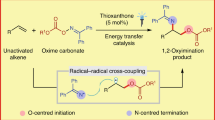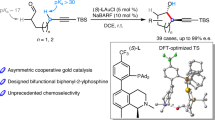Abstract
PROPARGYL alcohol and propargyl amine are of particular structural interest, because they belong to the rare class of substituted derivatives of methanol and methylamine in which the only possibilities of rotational isomerism are those associated with the COH or CNH2 groups. We have assigned microwave spectra for six isotopic forms of propargyl alcohol and for the normal form of propargyl amine. The moments of inertia show that the rotamers concerned are those in which the OH and both NH bonds occupy gauche positions, that is, subtend dihedral angles in the region of 60° with respect to the acetylenic group. In the alcohol, the properties of the potential function for internal rotation are reflected in the occurrence of spectra of molecules in a very low-lying excited state and in the occurrence of series of spectral lines with first-order Stark effects.
This is a preview of subscription content, access via your institution
Access options
Subscribe to this journal
Receive 51 print issues and online access
$199.00 per year
only $3.90 per issue
Buy this article
- Purchase on SpringerLink
- Instant access to full article PDF
Prices may be subject to local taxes which are calculated during checkout
Similar content being viewed by others
References
Murty, A. N., and Curl, R. F., J. Chem. Phys., 46, 4176 (1967).
Hirota, E., J. Mol. Spectrosc. (in the press).
Author information
Authors and Affiliations
Rights and permissions
About this article
Cite this article
BOLTON, K., OWEN, N. & SHERIDAN, J. Molecular Structures of Propargyl Alcohol and Propargyl Amine from Microwave Spectra. Nature 217, 164 (1968). https://doi.org/10.1038/217164a0
Received:
Published:
Issue date:
DOI: https://doi.org/10.1038/217164a0



